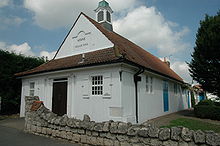- Clough Williams-Ellis
-
Sir Clough Williams-Ellis 
Born 28 May 1883
Gayton, Northamptonshire, EnglandDied 9 April 1978 (aged 94) Work Projects Creator of the Italianate village of Portmeirion in North Wales Sir Bertram Clough Williams-Ellis, CBE, MC (28 May 1883 – 9 April 1978) was an English-born Welsh architect known chiefly as creator of the Italianate village of Portmeirion in North Wales.
Contents
Life
Origins, education and early career
Clough Williams-Ellis was born in Gayton, Northamptonshire, England, but his family moved back to his father's native North Wales when he was four. The family have strong Welsh roots and Clough Williams-Ellis claimed direct descent from Owain Gwynedd, Prince of North Wales.[1]
He was educated at Oundle School in Northamptonshire. Though he read for the natural sciences tripos at Trinity College, Cambridge, he never graduated. After a few months at the Architectural Association in London in 1903/4 (which he located by looking up "Architecture" in the London telephone directory) he worked for an architect for a few short months before setting up his own practice in London.
Plas Brondanw and Portmeirion
In 1908, he inherited a small country house, Plas Brondanw from his father, restoring and embellishing it over the rest of his life, and rebuilding it after a fire in 1951. He served with distinction in World War I serving first with the Royal Fusiliers and then the Welsh Guards with whom he was awarded the Military Cross. He began work on Portmeirion during the 1920s. Notably, Portmeirion formed the set for the cult 1960s TV show The Prisoner.
Later life
A fashionable architect in the inter-war years, Williams-Ellis' other works include buildings at Stowe in Buckinghamshire, and groups of cottages at Cornwell, Oxfordshire; Tattenhall in Cheshire and Cushendun, County Antrim, Northern Ireland. Williams-Ellis is also known for his design (in the 1930s) of the former summit building on Snowdon, which - after unsympathetic alteration in the 1960s and a long-term lack of maintenance - was described by Prince Charles as "the highest slum in Wales".
Williams-Ellis also served on several government committees concerned with design and conservation and was instrumental in setting up the British National Parks after 1945. He wrote and broadcast extensively on architecture, design and the preservation of the rural landscape.
Family
In 1915, Williams-Ellis married the writer Amabel Strachey. Their elder daughter, Susan Williams-Ellis, used the name Portmeirion Pottery for the company she created with her husband in 1961. Clough Williams-Ellis' great-nephew David Williams-Ellis is a renowned contemporary figurative sculptor.
Honours
In 1958, Williams-Ellis was made a Commander of the Order of the British Empire "for public services".[2] He was made a Knight Bachelor in the New Year Honours 1972 "for services to the preservation of the environment and to architecture".[3] At the time, he was the oldest person ever to be knighted. [4]
Death
Sir Clough Williams-Ellis died in April 1978, aged 94. In accordance with his wishes, he was cremated, and his ashes went to make up a marine rocket, which was part of a New Year’s Eve firework display over the estuary at Portmeirion some twenty years after his death.
Works
Architecture
Writings
- Reconography (by student in BEF, pseudodonym Graphite) Pelman (1919 and 4 editions)
- England and the Octopus, London, Geoffrey Bles (1928)
- Cottage Building in Cob, Pise, Chalk and Clay: a Renaissance (1919)
- The Architect, London, Geoffrey Bles (1929)
- Cautionary Guide to Oxford, Design and Industrial Association (1930), 32 pages
- Cautionary Guide to St Albans, Design and Industrial Association (1930) 32 pages
- Laurence Weaver – a Biography, London, Geoffrey Bles (1933)
- Architecture Here and Now, London, T Nelson and Sons (1934)
- The Adventure of Building: being something about architecture and planning for intelligent young citizens and their backward elders, London, Architectural Press (1946), 91 pages
- An Artist in North Wales, London, Elek (1946), pictures by Fred Uhlman, 40 pages
- On Trust for the Nation (2 vols), London, Elek (1947), pictures by Barbara Jones, 168 pages
- Living in New Towns, London (1947)
- Town and Country Planning, Longmans, Green, London and British Council (1951), 48 pages
- Portmeirion, The Place and its Meaning, London (1963, revised edition 1973)
- Roads in the Landscape, Ministry of Transport (1967), 22 pages
- Architect Errant: The Autobiography of Clough Williams Ellis, London, Constable (1971), 251 pages
- Around the World in Ninety Years, Portmeirion (1978)
- With others
- Clough & Amabel Williams-Ellis, The Tank Corps (A War History), London (1919)
- ____ The Pleasures of Architecture London, Jonathan Cape (1924)
- ____ and Introduction by Richard Hughes, Headlong Down the Years, Liverpool University Press (1951), 118 pages
- Susan, Charlotte, Amabel and Clough Williams-Ellis, In and Out of Doors, London, Geo Routledge and Sons (1937) 491 pages
- With John Maynard Keynes, Britain and the Beast, London, Dent (1937), 332 pages
- With John Strachey, Architecture (1920, reprinted 2009), 125 pages
- With Sir John Summerson, Architecture Here and Now
References
- ^ http://www.portmeirion-village.com/content.php?nID=16;gID=375;lID=1
- ^ "Supplement to the London Gazette". London Gazette. 31 December 1957. http://www.london-gazette.co.uk/issues/41268/supplements/10.
- ^ "Supplement to the London Gazette". London Gazette. 31 December 1971. http://www.london-gazette.co.uk/issues/45554/supplements/1.
- ^ http://www.portmeirion-village.com/content.php?nID=107;lID=1
External links
- North Antrim website with designs by Clough Williams-Ellis
- Official Portmeirion site
- Plas Brondanw
Categories:- 1883 births
- 1978 deaths
- People from South Northamptonshire (district)
- British architects
- Alumni of Trinity College, Cambridge
- Old Oundelians
- Commanders of the Order of the British Empire
- Knights Bachelor
- Recipients of the Military Cross
- Welsh Guards officers
- British Army personnel of World War I
- Royal Fusiliers officers
Wikimedia Foundation. 2010.


